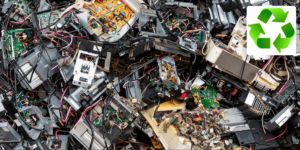
The Future Of E-Waste Recycling In Australia
When it comes to technological trash, it is evident that we must act quickly. According to the United Nations, up to 50 million tonnes of electronic waste are discarded each year globally, with the amount ending up in landfill increasing. In Australia alone, 234 million electronic products became ‘garbage’, being taken to landfill in 2009, 41 million more than previously thought.
According to a report by The Total Environment Centre and Environment Victoria, it was predicted that without an e-waste recycling programme, the amount of e-waste in Australian landfills could have trebled by 2020, reaching nearly 700 million items.
To prevent this from happening, the Victoria Government banned e-waste landfill by effect since July 1, 2019. But only a ban from a single state is not a solution. According to another report from Waste Electrical and Electronic Equipment (WEEE) Forum, in 2021, Australia recorded an e-waste dump of approximately 57.4 million tonnes.
So, what does the future hold for our E-waste, and what is being done to address this significant problem?
What Is The National Waste Policy?
With the establishment of the National Strategy for Ecologically Sustainable Development in 1992, the Australian government made headway on waste management policies. This pledged Australia’s commitment to reduce the environmental effect of all electronics and electrical assets that are deemed to be rubbish and placed into the ‘waste systems’ in Australia; also enhance hazardous material management and recycling. This would serve as the foundation for the government’s policies and programmes throughout the last 20 years and the Environment Protection and Heritage Council (EPHC), established in 2002.
The National Waste Policy (NWP) was developed in 2008 by Environment Minister Peter Garrett in collaboration with the Environment Protection and Heritage Council (EPHC). The policy recognises that while the National Strategy of 1992 successfully implemented curbside recycling schemes and raised awareness of sustainable waste management it required more in order to realise the change needed.
The NWP of 2008 aims to bring the strategy up to date and define a “clear direction” for the next ten years in light of the changing “waste stream”, particularly with the flood of hazardous waste from electronic goods. This policy also aims to comply with international responsibilities such as the Basel Convention and the Stockholm Convention, in order to reduce waste generation and ensure safe and environmentally sound treatment, disposal, recovery, and re-use practices.
One of this NWP’s key goals is to educate consumers about the dangers of hazardous waste and the significance of proper management and disposal. They plan to do so by implementing ‘product stewardship schemes’, focussing on producer accountability for the adequate disposal of hazardous waste, including electronic trash.
What Is a ‘Product Stewardship’ Program?
Under the planned product stewardship scheme, manufacturers would be responsible for recycling. They would be obliged to pay a levy on all televisions and computers brought into Australia in order to fund the expense of future recycling. The proposal was approved by the government, with the goal of having it operational by 2011.
The PSA is one of the most extensive government-backed initiatives to date, and it would give future generations easily accessible television recycling facilities. The system would be funded by financial payments from importers rather than consumers or the government. With PSA members representing 70% of all imported televisions, firms were already willing to contribute. By offering “direct economic advantages from employment development in all states,” this program would also assist the economy and citizens in regional areas.
Similar programs have been in place worldwide since 1996, demonstrating that they can function; and is a sign that Australia has a need to catch up.
The federal government’s full support and oversight are required to ensure participation and fair practices from all importers. Orphan and historical television sets, or electronic devices whose producers are no longer in business, are also concerned. As customers replace their equipment, these are undoubtedly the most likely candidates for landfill, but who will pay for their disposal?
Why Is It Important To Recycle E-Waste?
- Keeping electronic waste out of landfill is crucial. E-waste that is improperly disposed of is harmful to the environment and as a knock on effect humans and animals. Electronic equipment contains toxic compounds and heavy metals. Chromium, cadmium, mercury, and lead can all seep into the soil, poisoning the air and water.
- Globally, 60 million tonnes of e-waste is generated each year. To save landfill space, companies can recycle these items. As a result, numerous states have enacted legislation restricting e-waste from entering landfill.
- Electronic items are made up of precious metals such as gold, silver, and platinum, as well as copper, aluminium, plastic, and glass. Industry can reclaim these materials through the recycling process. The majority of electronic devices are pretty close to being 100% recyclable. It would be poor stewardship to dump these items and not recycle and reuse what we can for multiple ongoing purposes.
- The demand for new raw materials will be reduced when valuable materials are recovered from the recycling process. This will help to preserve critical natural resources. One metric tonne of circuit boards has 800 times the gold content of one metric tonne of ore… Wow!
- Recycling also helps minimise greenhouse gas emissions produced during manufacturing or processing “virgin material”. The demand for new material decreases as more recycled material becomes accessible.
How Is E-Waste Recycling Beneficial?
The advantages of recycling electronic waste are numerous, and the environmental impact is enormous.
It is impossible to overlook the importance of appropriate recycling for every business. Here are some examples of how it is advantageous:
Reduction in virgin resource mining
Harvesting tin from electronic components reduces the amount of tin extracted from subsurface resources.
Manufacturers have access to an environmentally friendly resource
The metallic and plastic components have traditionally come from a virgin source when you purchase a new electrical or electronic item. Instead, implementing the safe recycling of old electronics not only protects the environment from over-exploitation, but produces a new source of ‘raw materials’ without the waste of virgin extraction and processing to provide a starting point for manufacturing.
The negative impact is doubled when old units are discarded and not recycled.
Avoid the use of landfill
Landfill provides significant environmental risks to all living things, including humans, plants, and animals. When you fail to recycle electronic waste from your home or business properly, it winds up in the hands of waste haulers, who dump them into landfill.
The metallic, plastic and toxic components in this e-waste begin to leak through the large pile of garbage into the ground and potentially local water sources after a period of time.
We must avoid poisoning water bodies with toxic waste
Landfill is typically placed on or in the ‘land’, which is soil/dirt; allowing harmful chemicals to seep into surrounding water tables, via groundwater. People and animals alike will bear the effects of chemical poisoning over time, due to the toxic substances leaking into their drinking water.
E-waste recycling helps to keep the drinking water reservoirs clean and safe by preventing a significant proportion of these harmful components from leaking into these precious bodies of water. One of the advantages of recycling electrical and electronic waste is that it helps to keep our environment clean and water safe to drink.
Land and energy conservation
Metal manufacturing from mining different ores – requires a significant quantity of energy and space. The ecosystem can be severely damaged by digging and drilling holes underground and leaving them as wasteland. You’ll agree that property with gaping holes and pits is not appealing. Furthermore, some of these holes destabilise the surrounding earth when significant rain falls.
Electronic recycling can help save energy and prevent damaging our land globally by reducing the need for excessive mining. Energy is also a resource we can’t afford to waste(mining uses a lot of it, as does the manufacturing process for virgin metals), and conserving it is one of the advantages of recycling electronic and electrical waste.
It’s one way of saying thank you to mother nature for the beautiful gift we have in the earth and the self-sustaining ecosystem we all live together in.
Recycling e-waste contributes to cleaner air
One of the advantages of recycling electronic waste is the capacity to reduce hazardous gas pollution in the atmosphere. You can help prevent dangerous chemicals from being discharged into the air by adequately recycling old and unused electrical gadgets rather than burning them.
Perhaps you’ve noticed that high temperatures on electronic components cause them to smell bad.? This is a sign that they are releasing hazardous chemicals into the air, which are detrimental to you and every other living creature.
Mining also involves blasting rocks, which in turn releases gases like carbon dioxide, sulphur dioxide, and dust into the atmosphere. For example, 1 tonne of gold or platinum emits approximately 10,000 tonnes of CO2. Electronic recycling reduces hazardous gas emissions by a substantial percentage and helps the environment.
Electronic recycling helps to keep agricultural soil healthy
E-waste recycling prevents dangerous chemicals from leaking into the soil and rendering it useless, because it is then poisonous to plants, rendering growth impossible. Proper recycling methods also help to minimise too many toxic fumes and harmful dust being released into nearby agricultural areas. Agriculture provides a living for a considerable portion of the world’s population. Therefore keeping the areas productive and safe to grow plants is critical to general human well-being!
Promoting activities that protect the integrity of soil, agriculture, and the creation of natural green resources for plants, animals, and humans is what we need to do.
Cleaner air and a safer home and working environment is the aim and are all benefits of a greener environment; the eventual outcome of recycling e-waste.
Minimise environmental health risks
Residents of environmentally affected areas have cited health problems such as skin disease due to the toxic nature surrounding poor waste disposal habits; including e-waste which more often than not transmits hazardous material waste into the ground and water tables.
When the environment suffers, the people suffer as well.
E-waste recycling done correctly helps protect the environment from dangerous compounds that could harm the people living in close proximity and the surrounding natural resources. By safely recycling e-waste, environmental concerns can be limited; such as contamination from heavy metals, harmful fumes, and dust from badly managed mining operations and burning garbage.
Encourage the use of fishery resources
E-waste has a complicated mixture of components that are poisonous and can leak into water bodies and kill fish and other aquatic species when disposed of in landfill. A substantial amount of lead, copper, mercury, cadmium and other toxic materials are released into streams and rivers, eventually killing aquatic life. Mercury, for example, is a neurotoxin capable of killing in seconds. Scientists have recently discovered that dead fish in sea and waterbed deposits carry elevated mercury levels linked to human activities near water sources.
E-waste recycling helps to keep the water clean and safe for aquatic animals and plants. As a result the correct and safe methods of recycling assist in preserving the freshwater ecosystem of plants, animals, and even people who rely on it for their livelihood.
More recycling resources are available
You can find E-waste recycling sites all over the world. These recyclers in turn supply the recycled materials back to industry for reuse; as more electronic garbage is handed over to them. When you dispose of unused or end-of-life electronics in the correct manner, you are helping to create resources that are better for the environment than when the process of product creation starts from zero with mining and refining.
Choose Secure Hard Drive Destruction!
Recycling begins with you and progresses via the electronic industry’s various stakeholders. If you throw your devices in the rubbish bin or garbage, they will almost certainly end up in landfill; something the Government and environmental lobbyists are desperately trying to stop from happening.
Some of these types of garbage (which have already been sent to landfill) end up in under-developed countries, where they are just dumped. There are settlements of people who inhabit these areas, which are then helplessly endangered.
Secure Hard Drive Destruction (SHDD) takes care of e-waste in a responsible manner; working with numerous recycling service providers all over the globe to make sure that every bit and piece that can be recycled is. You end up with a certificate for recycling and the proper disposal of hazardous materials.
We often work with companies that require a higher level of security for their end-of-life assets while also considering the environmental and long-term benefits that recycling can deliver.
Secure Hard Drive Destruction’s goal is to provide an end-to-end disposal service which is secure and environmentally friendly. We specialise in the destruction of highly classified ICT media and assets, ITAR, weapons, explosive ordnance (free of explosives), and systems from end-of-life Defence vehicles (Air/Sea/Land).
Share It On :-
More Posts


Hard Drive Destruction vs. Data Wiping: Which Is More Secure?

The Benefits of Professional Shredding Services: Safeguarding Your Confidential Information

The Importance of E-Waste Management in Corporate Social Responsibility

What Happens to Your Data During Secure Hard Drive Destruction?


